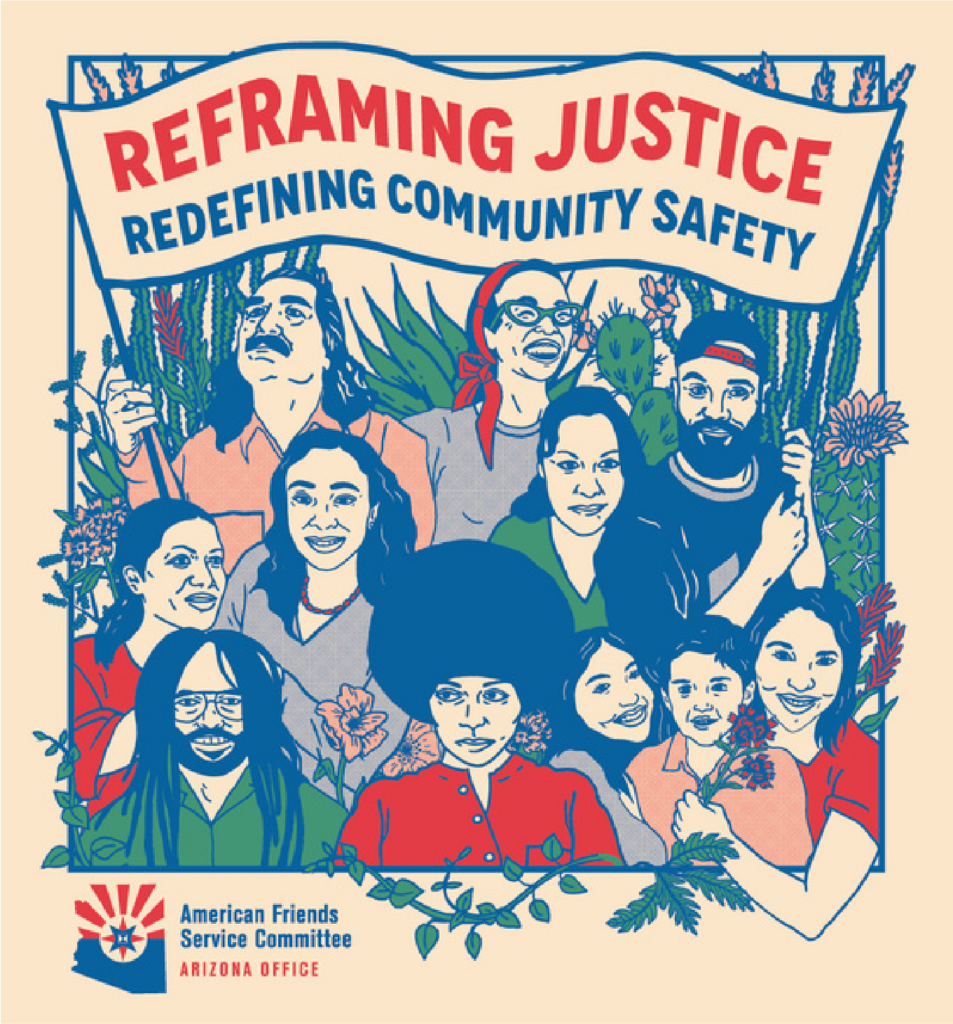Series Methodology & Summary
This Inside-Outside collaborative project began as a mixed-methods investigation into sentencing issues in the state of Arizona, as directed by currently and formerly incarcerated women.
To conduct this analysis, our collective formed a team of seven co-researchers currently incarcerated at Perryville along with several outside collaborators. The research design, interview questions, coding schema, data analysis, theme interpretation, section outlining, policy recommendations, and report authorship were collectively executed. This research reflects the wisdom of our collective and participants in a co-constitutive manner; our resulting analysis draws upon roughly three dozen 2- to 3-hour in-depth interviews, drift field notes, collective discussion, and extensive personal experience. In this project, as with any work attempting to investigate the truth of systems of oppression, the knowledge among those most intimately embedded within this system is paramount. Where relevant, we have supplemented our qualitative analysis with national and state-wide data as well as historical developments in Arizona’s punishment system.
We have determined that, to accurately understand the consequences of sentencing patterns in Arizona, we had to analyze four overlapping sites of capture:
Pathways into the punishment system: how our people become entangled in the system, including the conditions by which our communities are abandoned and criminalized.
The fight and the decision: the jail and court process, from coercive proceedings to insurmountable sentences.
Becoming wards of the state: the punishment to which people are sentenced, including the conditions of confinement, labor, medical care, and parenting from behind bars.
The post-release life tail: the lifelong reverberations of imprisonment, the complex barriers to returning home to communities, and the difficulties in healing individually and socially.

Our research found patterns related to experiences of trauma, discrimination, exploitation, and egregious state violence from police, court officials, prison staff, and community resource agents.
These patterns were consistent across the four categories of analysis listed above. Additionally, experiences were invariably racialized and gendered:
Trauma
The Arizona Punishment System overwhelmingly entraps individuals with histories of physical, sexual, and emotional trauma, and then subjects them to compounding trauma and disempowerment at every stage of interaction with its institutions and agents while espousing rhetoric of reform and rehabilitation.
Discrimination
Communities already disproportionately affected by “organized abandonment” are targeted through policing, harsher sentencing, imprisonment patterns, separation of families, and lifelong marginalization.
Exploitation
The Arizona Punishment System is driven by a combination of vast public spending and extreme private profit, while those entrapped in it subsidize its ability to persist at the expense of their dignity and livelihood.
State Violence
Officials in virtually every segment of the system enforce surveillance and control by physical, psychological, and sexual abuse—feeding their arrest and incarceration rates through manipulation and intimidation; “securing” prison environments through restraints, assaults, and bodily violations; and structurally denying adequate shelter and employment post-release while maintaining the omnipresent threat of
re-incarceration.
These findings demonstrate the correlation between “justice” and oppression reproduced by the Arizona Punishment System.
The insights from our mixed-method analysis reveal Arizona to be a grave local exemplar of nation-wide trends regarding racial and gender-based differential arrests, incarceration, extreme sentencing, and marginalization post-release.
Significantly, this series unveils the ways the punishment industry disappears and silences those of us within it and keeps most of these conclusions from the public eye. We reject this by centering our unfiltered, lived experiences enduring the violences at the core of this system.
The Drapetomania Collective and our supporters at the Reframing Justice Project of the American Friends Service Committee of Arizona signal the call for the dismantling and defunding of this retributive system; and the redistribution of institutional and social supports that have been ravaged in our communities.
Further, we call for a similarly abolitionist-oriented interrogation of reform proposals that serve to expand, rather than contract, the web of capture. We recommend policy measures that decarcerate and revoke elements of state-control and surveillance, so that our communities have increased opportunity to heal from disproportionate devastation under this system.
Finally, we embody and propose alternative notions of justice which address harm by centering care, growth, and actual community safety.
Sentencing policy recommendations we make in this series include:
Repeal Truth in Sentencing structures, including the 85% sentence requirement
Re-establish state parole board abolished in 1993; allow for actual early release opportunities
Grant parole hearings to those sentenced to indeterminate sentences, including the opportunity for release for those sentenced between 1994-present (following the abolition of parole)
Reconstruct the processes and parameters of the Arizona Board of Executive Clemency such that they provide reasonable possibility of early release
Revise ARS. codes that disqualify applications for medical clemency for imminent danger of death; and make this option available at any time and regardless of charges
Reduce indeterminate sentences to extend no longer than 10 years prior to parole hearing opportunity
- Disallow the sentencing of children as adults
- Repeal the felony murder statute
- Repeal mandatory minimum sentences
- Revoke discriminatory prosecutorial discretion, especially regarding pleas
- Establish routes for retaining family unification and dismantle provisions that terminate parental rights due to incarceration
- Eliminate bail, electronic monitoring and other costly punitive reforms
- Decarcerate without replacing prison time with probation or electronic monitoring
- Eliminate electronic monitoring as an alternative to bail
- Dismantle probation as punishment and remove insurmountable stipulations that justify re-incarceration
We make several ADCRR institutional policy recommendations throughout this series, including:
- Repeal priority ranking system within state prisons
- Establish means of consistent family visitation, not to be denied under any circumstance
- Grant public access and oversight of Director and ADCRR so that the concerns of those currently incarcerated are heard
- Provide adequate nutrition inside state facilities
- Provide adequate medical and mental health care inside state facilities
- Stop killing prisoners. Stop hurting prisoners. Stop violating prisoners. Hold state actors accountable for any and all use of violence.
- Provide livable wages and dignified work opportunities inside state facilities; increase prison wages for the first time since 1977.
- Create a regulating body to oversee private contracts within public prisons, including medical, communication, and commissary, regarding cost and access
- Provide re-entry resources that establish housing, employment, and counseling; make these resources available to all.
- Ensure that living conditions are livable, as according to residents and outside oversight committee
- Follow through on the obligation to provide all state issue items, including clothing, shoes, bedding, and hygiene items as required by existing ADCRR policy
- Provide free and unlimited access to feminine hygiene products
- Treat pregnant women with care and respect, including prenatal health supervision, dignified, unshackled labor, and adequate and private time with infant; ensure that male officers are never present
- Provide access to legal materials and paralegal advising
Keywords:
- punishment system
- prison industrial complex
- web
- organized abandonment
- criminalization
- surveillance
- trauma
- reform
- truth in sentencing
- felony murder
- life without parole (LWOP)
- testimonio
- privatization
- dehumanization
- abuse
- power
- control
- parenting
- care
- release
- parole


